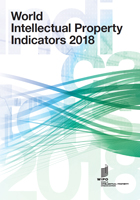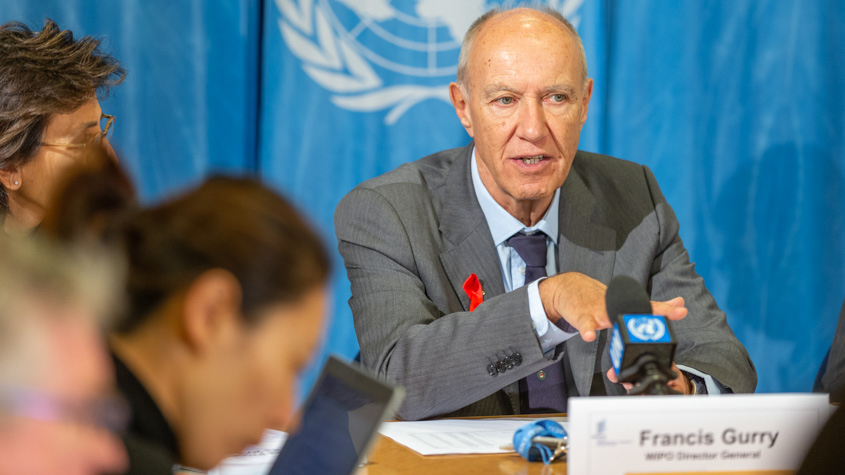World Intellectual Property Indicators: Filings for Patents, Trademarks, Industrial Designs Reach New Records on Strength in China
Geneva,
December 3, 2018
PR/2018/826
Go to: Patents | Trademarks | Industrial designs | Plant varieties | Geographical indications | Creative economy
Worldwide demand for intellectual property (IP) tools reached record heights in 2017, with China driving the growth in filings for patents, trademarks, industrial designs and other IP rights that are at the heart of the global economy.
Video: Press conference Video (Watch on YouTube) | Interactive charts: Barchart
Innovators across the globe filed 3.17 million patent applications in 2017, up 5.8% for an eighth straight yearly increase, according to WIPO’s annual World Intellectual Property Indicators (WIPI) report. Global trademark filing activity totaled 12.39 million, while that for industrial designs reached 1.24 million.
China recorded the highest application volume for each of these IP rights as innovators and creators inside the country, as well as foreign entities, seek to protect and promote their work in one of the world’s fastest-growing major economies.

World Intellectual Property Indicators – 2018
An authoritative annual survey of IP activity around the globe.
Download
At a glance
Download“Demand for IP protection is rising faster than the rate of global economic growth, illustrating that IP-backed innovation is an increasingly critical component of competition and commercial activity,” said WIPO Director General Francis Gurry. “In just a few decades, China has constructed an IP system, encouraged homegrown innovation, joined the ranks of the world’s IP leaders - and is now driving worldwide growth in IP filings.”

Worldwide plant varieties applications grew by 11.7% to reach 18,490 applications in 2017, while data received from 82 national and regional authorities show the existence of around 59,500 protected geographical indications (GIs) in 2017.
| IP right | Filing activity in 2017 |
|---|---|
| Patent applications | 3,168,900 |
| Number of classes specified in trademark applications | 12,387,600 |
| Number of designs contained in industrial design applications | 1,242,100 |
| Plant variety applications | 18,490 |
For the first time, WIPO is reporting statistics on the creative economy. Publishing industry revenue of 11 countries covering three sectors amounted to USD 248 billion in 2017.
Patents
China’s IP office received the highest number of patent applications in 2017, a record total of 1.38 million. China in 2017 refined its method for compiling statistics for patents and industrial designs applications, counting only those for which application fees have been paid. China’s IP office was followed by the offices of the United States of America (U.S.; 606,956), Japan (318,479), the Republic of Korea (204,775) and the European Patent Office (EPO; 166,585).
The top five offices accounted for 84.5% of the world total. Among these offices, China (+14.2%) and the EPO (+4.5%) saw strong growth in filings, while Japan (+0.03%) and the U.S. (+0.2%) saw negligible growth. The Republic of Korea (-1.9%) received fewer applications in 2017 than in 2016.
Germany (67,712), India (46,582), the Russian Federation (36,883), Canada (35,022) and Australia (28,906) also featured among the top 10 offices. Australia (+1.8%), Canada (+0.8%) and India (+3.4%) saw growth in filings, while Germany (-0.3%) and the Russian Federation (-11.3%) experienced a decline in filings.
Video: Director General on patents Video
Asia going strong
Asia has strengthened its position as the region with the greatest activity in patent filings. Offices located in Asia received 65.1% of all applications filed worldwide in 2017 – a considerable increase from 49.7% in 2007 - primarily driven by growth in China.
Offices located in North America accounted for 20.3% of the 2017 world total – six percentage points below its 2007 share. Europe’s share declined from 18.1% in 2007 to 11.2% in 2017. The combined share of Africa, Latin America and the Caribbean, and Oceania was 3.4% in 2017.
Patenting activity beyond borders
In filing abroad, which is an indication of a desire to expand in new markets, U.S. residents continue to lead with 230,931 equivalent patent applications filed abroad in 2017. The U.S. was followed by Japan (200,370), Germany (102,890), the Republic of Korea (67,484) and China (60,310).
Among these five origins, China reported a 15% growth in filings abroad, which is far above that of Japan (+2.1%) and the U.S. (+2%). Both Germany (-0.6%) and the Republic of Korea (-4.1%) had fewer filings abroad in 2017 than in 2016.
Patents in force worldwide grew by 5.7% to reach 13.7 million in 2017. Around 2.98 million patents were in force in the U.S., while China (2.09 million) and Japan (2.01 million) each had around 2 million.
Trademarks
An estimated 9.11 million trademark applications covering 12.39 million classes were filed worldwide in 2017. The number of classes specified in applications grew by 26.8% in 2017, marking the eight consecutive year of growth.
The IP office of China had the highest volume of filing activity[1] with a class count of around 5.7 million, followed by the U.S. (613,921), Japan (560,269), the European Union Intellectual Property Office (EUIPO; 371,508) and the Islamic Republic of Iran (358,353). Among the top 20 offices, the Islamic Republic of Iran (+87.9%) and China (+55.2%) reported high annual growth. At both of those offices, strong growth in resident filings drove the overall growth. Japan (+24.2%), the U.K. (+24.1%) and Canada (+19.5%) also saw considerable growth.
Video: Director General on trademarks Video
Asia leads in trademark filings
Offices located in Asia accounted for 66.6% of all trademark filing activity in 2017, up from 36.1% in 2007. Europe’s share declined from 38.9% in 2007 to 17.7% in 2017. North America accounted for 6.4% of the world total in 2017, while the combined share of Africa, Latin America and the Caribbean, and Oceania was 9.2% in 2017 – five percentages points below their combined 2007 share.
Trademarks associated with advertising and business management accounted for 11% of global trademark filing activity in 2017, followed by clothing (7%), computers, software and instruments (6.6%) and education and entertainment (5.5%).
There were an estimated 43.2 million active trademark registrations worldwide in 2017 – up 9.7% on 2016, with 14.9 million in China alone, followed by 2.2 million in the U.S., 1.9 million in Japan and 1.6 million in India.
Industrial designs
An estimated 945,100 industrial design applications containing 1.24 million designs were filed worldwide in 2017.
The office of China received applications containing 628,658 designs in 2017, corresponding to 50.6% of the world total. It was followed by the EUIPO (111,021), the KIPO (67,357), Turkey (46,875) and the U.S. (45,881). Among the top 20 offices, the fastest growth in design counts occurred in the U.K. (+92.1%), Spain (+23.5%) and Switzerland (+17.9%).
Asia sees highest design activity
Offices located in Asia accounted for more than two-thirds (67.9%) of all designs in applications filed worldwide in 2017, followed by Europe (24.4%), North America (4.2%), Africa (1.5%), Latin America and the Caribbean (1.2%), and Oceania (0.7%).
Designs related to furnishings accounted for 10% of global filing activity[2] , followed by those related to clothing (8.5%) and to packages and containers (7.2%).
The total number of industrial design registrations in force worldwide grew by 5% to reach 3.75 million. Around 1.46 million (38.9% of world total) were in force in China, followed by the Republic of Korea (339,350), the U.S. (321,314), Japan (254,060) and the EUIPO (210,605).
Plant varieties
China became the top filing office in 2017, receiving 4,465 plant variety applications, followed by the Community Plant Variety Office of the European Union (CPVO; 3,422), the U.S. (1,557), Ukraine (1,345) and Japan (1,019). China saw a 52.8% growth in 2017. Ukraine (+5.6%), Japan (+4.3%) and CPVO (+3.7%) also saw growth while the U.S. reported a 2.9% drop in filings.
Geographical indications
In 2017, there were 59,500 geographical indications (GIs) in force worldwide. GIs are signs used on products that have a specific geographical origin and possess qualities or a reputation that are due to that origin, such as Gruyère for cheese or Tequila for spirits.
Germany (14,073) reported the largest number of GIs in force, followed by Austria (8,749), China (8,507), Hungary (6,646) and the Czech Republic (6,191). There were 4,932 European Union GIs in force in each of the EU member states.
GIs in force relating to “wines and spirits” accounted for around 57% of the 2017 world total, followed by agricultural products and food stuffs (28.2%) and handicrafts (2.7%).
Creative economy
Revenue generated by the three sectors (trade, educational and scientific, technical and medical) of the publishing industry of 11 countries amounted to USD 248 billion. China reported the largest net revenue (USD 202.4 billion), followed by the U.S. (USD 25.9 billion), Germany (USD 5.8 billion) and the U.K. (USD 4.7 billion)[3].
Digital editions generated 28.3% of the total trade sector revenue in China, 23.5% in Japan, 18.4% in Sweden, 13.2% in Finland and 12.9% in the U.S.
The U.S. sold 2,693 million copies of published titles in 2017, followed by the U.K. (647 million), Brazil (617 million) and France (430 million).
About WIPO
The World Intellectual Property Organization (WIPO) is the United Nations agency that serves the world’s innovators and creators, ensuring that their ideas travel safely to the market and improve lives everywhere.
We do so by providing services that enable creators, innovators and entrepreneurs to protect and promote their intellectual property (IP) across borders and acting as a forum for addressing cutting-edge IP issues. Our IP data and information guide decisionmakers the world over. And our impact-driven projects and technical assistance ensure IP benefits everyone, everywhere.
For more information, please contact the News and Media Division at WIPO:- Tel: (+41 22) 338 81 61 / 338 72 24